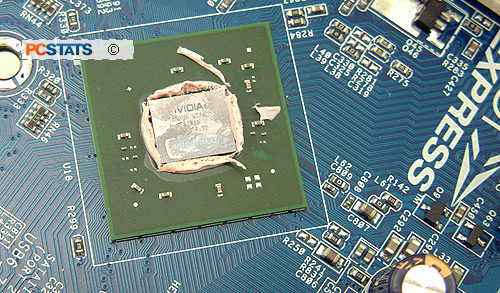
The nVIDIA GeForce 7050PV/nForce 630a chipset has integrated HDCP. HDCP ensures
Blu-Ray and HD-DVD plays at its full resolution.
The GeForce
7050PV offers video output options on par with AMD's impressive 690G chipset,
and realistically either option is a good choice. Built on TSMC's 80 nm
manufacturing process, nVIDIA was able to integrate the GeForce 7050PV
Northbridge and nForce 630a Southbridge into a single tiny slab of silicon. In
practical terms this means compact motherboards based on this chipset should run
pretty cheap because there is only one core logic.
Looking at
the chipset on the ASRock Alive-NF7G-HDready motherboard we can see
"NF-7050-630A-A2" marked onto the silicon. This indicates that the A2 stepping
is for the retail market.
The GeForce
7050PV-nForce 630A support nVIDIA's PureVideo and the onboard GeForce 7 series
videocard is DirectX 9.0C and ShaderModel 3.0 compatible (Microsoft Windows
Vista Ultimate Ready). The GeForce 7050 onboard graphics does not have its own
memory and will grab a bit of system memory for its own use, up to
256MB.
 The GeForce 7050 supports
HDMI although it's up to the manufacturer to implement it on the motherboard (in this case
the jack is not included). HDCP is now supported by default, that means
you get to watch high definition content at maximum settings whether you're
viewing it on your computer monitor or television. Of course if you want to
watch standard definition video, the GeForce 7050 can handle that too but it
depends on the motherboard manufacturer to offer standard definition
output.
The GeForce 7050 supports
HDMI although it's up to the manufacturer to implement it on the motherboard (in this case
the jack is not included). HDCP is now supported by default, that means
you get to watch high definition content at maximum settings whether you're
viewing it on your computer monitor or television. Of course if you want to
watch standard definition video, the GeForce 7050 can handle that too but it
depends on the motherboard manufacturer to offer standard definition
output.
There really
aren't any significant differences between the GeForce 7050PV and the GeForce
6150 other than the two items that we mentioned up above. This is a really smart
move by nVIDIA because the GeForce 6150 chipset is one of the most popular
chipsets that PCSTATS has ever tested.
The really
cool features are an integrated TV encoder, DVI and 15 pin DSub monitor support.
nVIDIA's GeForce 7050PV does support dual monitors (if the manufacturer allows
for two connectors), but because of the chipset design one monitor (or TV) will
have to use an digital signal like DVI or HDMI while the other uses the analog
(like the 15 pin DSub or S-Video channel).
